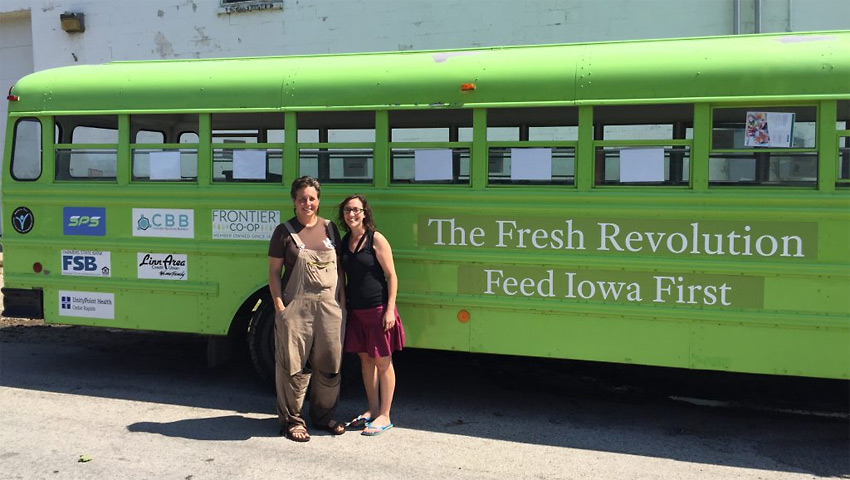This Veterans Day, I wanted to profile an amazing veteran-turned-farmer, Sonia Kendrick, and share her inspiring vision for how increasing opportunities for new farmers might eliminate food insecurity. Sonia’s channeled her post-war trauma into a successful non-profit that grows healthy food across her hometown of Cedar Rapids, Iowa. Through her organization she also trains beginner farmers, something needed on a large scale to succeed the current aging agricultural workforce.
I first met Sonia in 2011, when she was my short-term roommate while I was a graduate student and she worked toward her undergraduate degree at Iowa State University. Sonia served in Afghanistan from 2003-2004 as part of the Iowa National Guard and one of the most powerful stories she’d share was her witnessing many Afghanis in painful poverty and desperation.
After Sonia returned home, she couldn’t shake the vivid images of food insecurity in Afghanistan: the agonizing scenes of women pulling food from the bottom of Military dumpsters or children crossing minefields to reach bread trucks. She simply refused to accept that there should be hungry people in her home state of Iowa, which proudly boasts of itself as a major “food” producer. Anyone familiar with Iowa’s commodity crop landscape is aware that almost none of those crops go to feed people, but rather to animal feed, high fructose corn syrup, and ethanol.
Why not “feed Iowa first”?
Sonia never shies away from sharing the numbers in her home of Linn County: according to Feeding America, there are 26,080 food insecure people there. Her passion drove her to find spare urban land and to grow healthy food for her community, founding the non-profit organization Feed Iowa First with that spirit in mind: Let’s start by feeding our community first, before we go about boasting how we might feed the world.
It all started on the land of one church in Cedar Rapids in 2011. Now she oversees 22 different farms around the city, including churches and local businesses, as well as a storage facility, space donated to her by Cargill. The idea is to task one local volunteer to oversee the location, and to grow the same family of vegetables (rotating the crops grown year to year on each plot of land, to protect the soil and avoid pest issues) to try to keep the management simple for others who might not be as familiar with the particular crop.
Last year Feed Iowa First gave away $83,000 worth of produce, or approximately 35,000 pounds. If you count roughly one pound of vegetables to represent one cup or one serving, that is still hardly scratching the surface of providing healthy food for the 26,080 food insecure people in Linn County.
Sonia also recognizes the shortcomings of the volunteer charity approach to combating hunger, and she’s still seeking a more sustainable economic model for the organization. It is clear as day to Sonia that this approach is not isolationist, but rather a safety net for food security and climate change. Sonia is grateful for the support that she’s received from organizations, both large and small, recognizing industry as a critical player in creating a more localized food economy.
Not only growing food, but growing beginner and veteran farmers is critical
Sonia is pleased to see the progress of “Incubator” programs that help train and support beginner farmers. But she also believes that these incubators are not training enough new farmers by an order of magnitude. She estimates that her county alone would need 3,000 additional acres of vegetable production, which would ideally require about 85-90 more lead farmers and dozens more people to help manage the land. For perspective on finding 3,000 acres in Linn County to grow vegetables: USDA estimates there are approximately 450,000 acres of land, and in 2015, 151,000 acres were planted with corn and another 105,000 planted with soybean.
Sonia uses Feed Iowa First to provide the initial training needed for beginner farmers to qualify for Farm Service Agency (FSA) loan assistance in purchasing land. For active service members, she further proposes farming become a military occupational specialty code, such that valuable skills are transferred to service members and farming becomes more of a trade or craft occupation.
This seems so logical to her; Sonia describes that she feels she’s serving the country by growing healthy food, not to mention all of the healing that comes with the privilege of working the land.
Supporting veterans to help grow farmers and reduce food security is a win-win-win
The Veteran Farmer Coalition (VFC), founded in 2007, has successfully helped implement programs in the most recent Farm Bill that support loans and access to conservation programs for veterans as well as encouraging USDA to create a Military Veteran Agricultural Liaison position (which they did in 2014). Programs exist all across the country to support veteran farmers – from Virginia to Colorado to Oregon.
It is well documented that the average age of farmers in the United States is 58 years old. It is also noted that rural communities disproportionately lost service men and women in the Afghanistan and Iraq wars. Many veterans already possess the entrepreneurial spirit that Sonia carries and along with the leadership and problem-solving skills gained through military service, it makes agriculture a natural fit for those home from war. It’s a win-win-win in my opinion: strengthening farming opportunities for veterans, bolstering an aging farming workforce, and helping reduce urban and rural food insecurity. When I think of all that Sonia has achieved as one dedicated individual, I only imagine what might be possible if more veterans had better access to achieve their agricultural aspirations.

